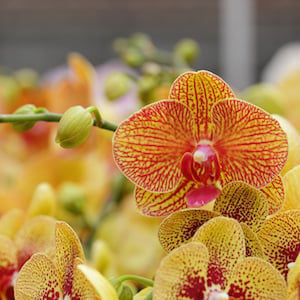
At Just Add Ice® Orchids, we don’t like to play favorites. But when it comes to seasons, we just can’t help ourselves! Spring is a favorite season of ours because orchids in nature will typically bloom in early spring. The season also presents a number of opportunities to showcase our favorite flower, from incorporating orchids into a wedding to decorating with orchids throughout your home.
Fall is another favorite. Sure, much of our love for fall stems from enjoying pumpkin-flavored treats. But we also favor fall because it is the optimal season to trigger orchid reblooming!
Phalaenopsis orchids go through a resting phase after blooming sometimes called dormancy. This resting period typically lasts for six to nine months but can vary from plant to plant. As an orchid enters into the resting phase, its blooms will wilt and fall off, its stem may shrivel or turn brown, and its leaves will gradually lose their bright green color and upright stance. Seeing this, new orchid owners will often think their plant has died—it hasn’t! Instead, it’s storing up energy to bloom again.
In nature, Phalaenopsis orchids will grow new leaves in the summer and early fall and develop a spike in the late fall when temperatures drop. This drop in temperature is what makes fall the best season to trigger reblooming.
Typically, you want to keep your orchid in a room with daytime temperatures that range between 65 to 80 degrees and nighttime temperatures that range between 55 and 65 degrees. To encourage reblooming, we recommend you keep your orchid in a room with lower temperatures (between 55 and 65 degrees) for one to two weeks.
Temperature is the primary trigger for orchid reblooming; however, there are other steps you can take that may help your orchid bloom again. Increasing your plant’s exposure to indirect sunlight is one example.
Because an orchid loses its blooms as it enters its resting phase, many orchid owners will move the plant to an area of the home where it won’t be as visible. More often than not, that new area does not give the plant enough exposure to the amount of indirect sunlight it needs. To encourage reblooming, make sure your plant receives the same amount of bright indirect light it enjoyed while in bloom. You can even dress up the orchid stake (the wooden stick that supports an orchid spike) with silk orchid blooms!
Trimming the orchid spikes is another way to encourage reblooming. For a step-by-step guide on trimming orchid spikes, see our previous blog.
Like the plants you see outside, your orchid’s blooms may be wilting and its leaves may be falling. Unlike many of those plants, with a little TLC, your orchid can rebloom again come spring. For more help with orchid reblooming, download our helpful guide.

Copyright Just Add Ice® Orchids 2023